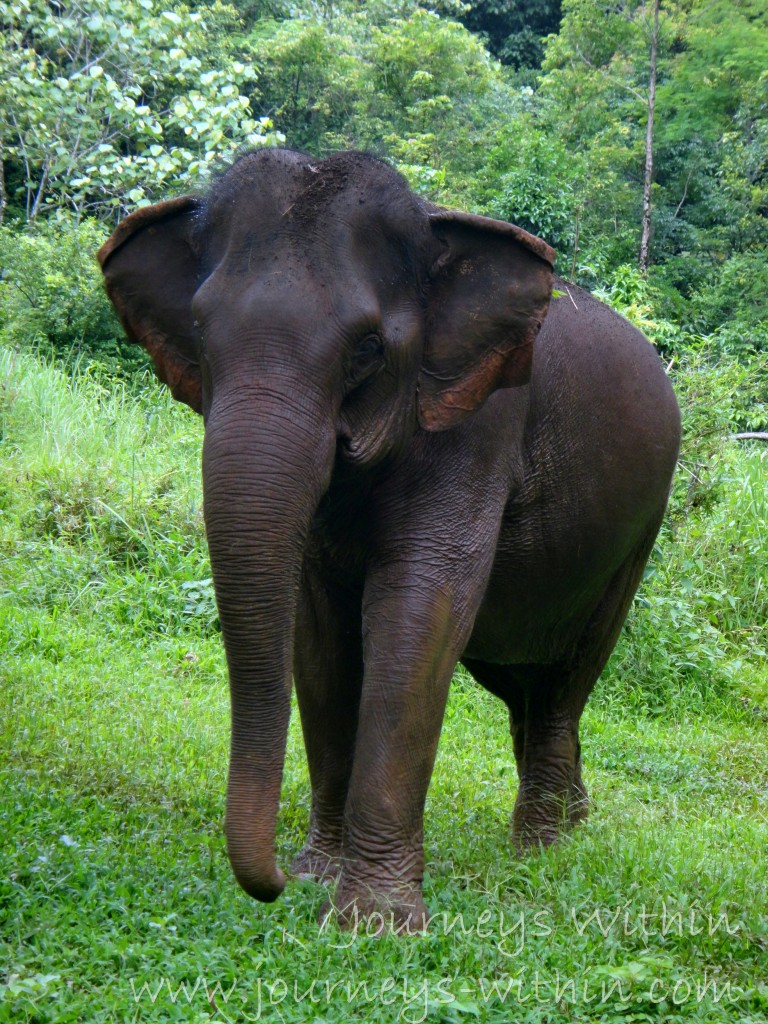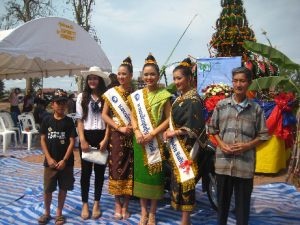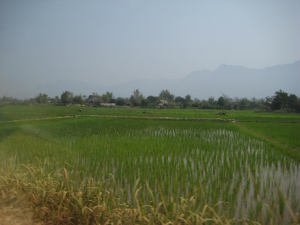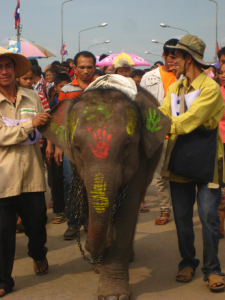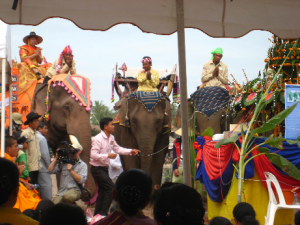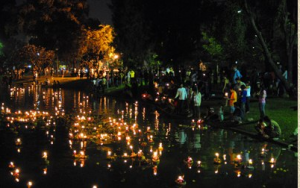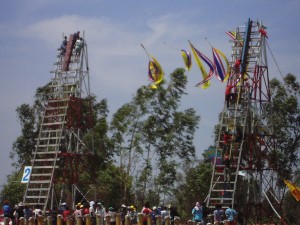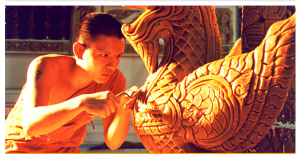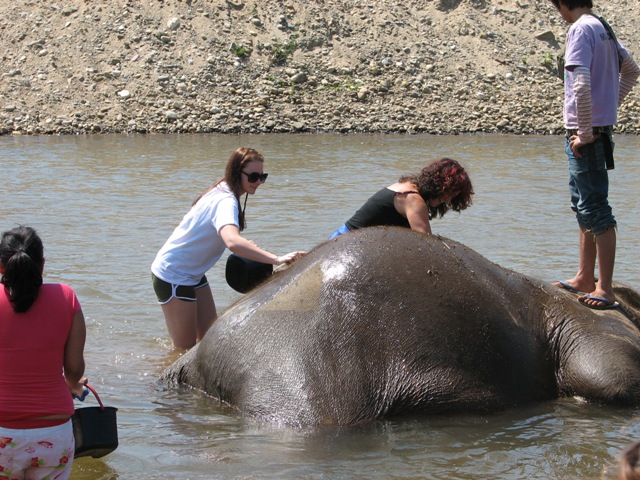
Over the next several weeks, some of the Journeys Within team is on our annual inspection tours throughout some of our Thailand, Laos, and Cambodia tour locations. This is an exciting time of the year for us to visit the countries we love and return home from our journeys revived with inspiration for travel, and with new stories to tell our followers.
I am Marketing and Booking Coordinator, Kena Cataneso, for our Truckee, California location. I will be blogging on behalf of Journeys Within this spring as I make my way through Bangkok, Chiang Mai, Chiang Rai, Luang Prabang, Phonesavanh, Vientiane, Pakse, and Siem Reap.

Follow my journey for updates and travel tips on some of our key locations and tours throughout the months of April and May, and get inspired for your own next adventure.
The first three days – An Introduction to Thailand: Bangkok, Chiang Mai, and Chiang Rai
For travelers who seek to acquaint themselves with highlights of Thailand, these Journeys Within tours are ideal:
Day 1: Bangkok: Public Transport City Tour with Klongs
Day 2: Chiang Mai: Elephant Daycare at Patara Elephant Farm
Day 3: In and Around Chiang Rai
These tours are customizable to the guest’s preferences and schedules, though Journeys Within can make recommendations on the best timing to schedule certain tours and activities to beat crowds and the sun on hot days.
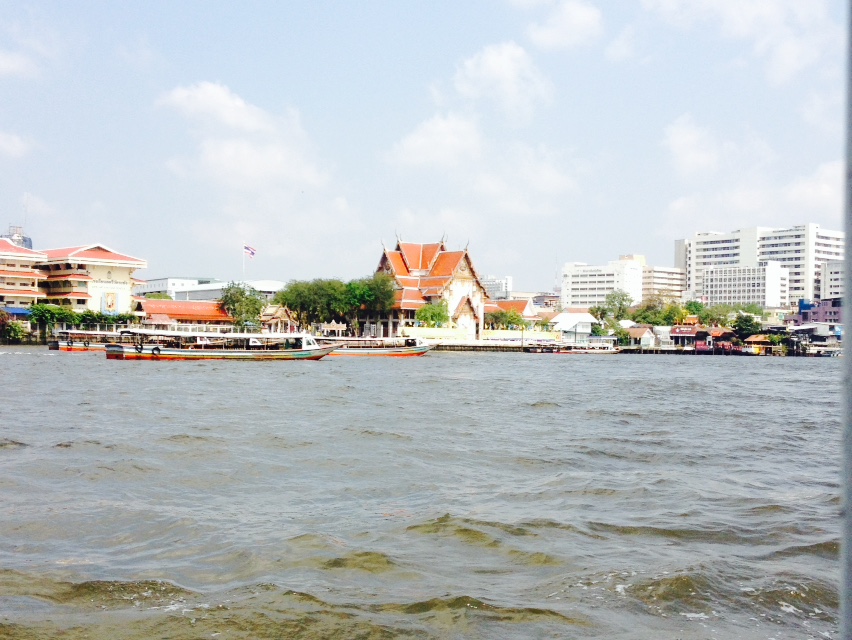
Bangkok: Public Transport City Tour with Klongs
Guests who arrive in Bangkok via international flight late in the evening prior to this tour have the option to be picked up at the airport by van with a Journeys Within guide. This is a favorable option as guests will typically experience fatigue, jet lag, and if you’re at all like me, disorientation and irritability after a day of flying with potential connections and delays.
I arrived in Bangkok an hour late, around midnight, due to a delay with my connecting flight in Korea. The process to go through immigration and to pick up my baggage took about one more hour, putting me at nearly 1 am. At that point, I would not want to navigate my own way to my hotel. Bangkok is large and taxis are expensive, and public transportation does not run 24 hours a day.
Guests can choose to arrange their own transportation or use a taxi from the airport to their hotel, but it’s worth speaking with a Journeys Within Tour Consultant to discuss their priorities, options, and budget. Our Journeys Within Tour Consultants are transparent with our guests about practicality with logistics.
I was thrilled to be met outside the baggage claim by my guide. He took my bags, and walked me to my air conditioned van where I was provided ice cold water and a fresh, cold towel.
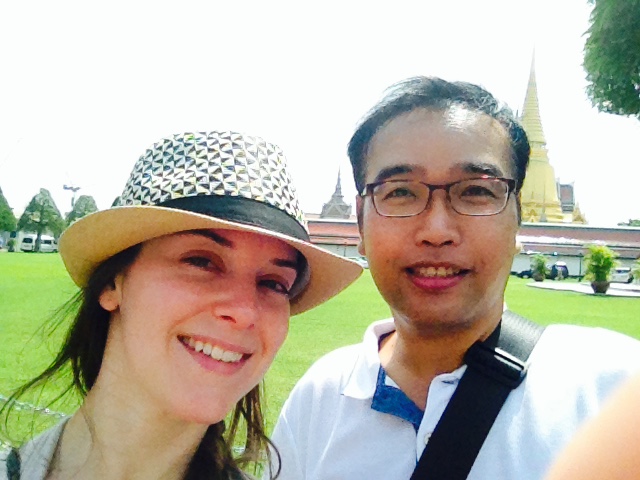
This time in Bangkok I inspected VIE Hotel, which is located a half hour from the airport. I was pleased to stay with VIE Hotel on my introduction night to Thailand. VIE is a large, modern hotel situated in the heart of Bangkok.
I haven’t traveled since last year, and frankly, it was a huge comfort to stay on my introduction night in an immaculate hotel with all the luxuries I would expect from a high-end hotel in the US. An insider tip to VIE – they automatically upgrade all guests to nicer rooms if they are available. I was upgraded to a suite.
The rooms are appointed with dark wood and the high ceilings provide a feeling of grandeur. Once I arrived at my room I promptly charged my electronics, which require no adapters for the power outlets, as they are compatible with standard US power cords. The restroom was equipped with a rain shower and fresh white bath robes.
I awoke the next morning reborn and ready to tour the city, especially after the complimentary international breakfast buffet, which is a veritable feast of international options.
Why public transport for the tour? The answer is simple; public transport in Bangkok is incredibly accessible, efficient, and inexpensive. The option of private transport by van may offer some guests a feeling of privacy and independence, however, traffic in Bangkok is heavy and guests using private transport will find themselves often sitting in traffic and with considerably less available time on their itinerary to tour.
I was met in the lobby by my guide and we were only a few minutes walk to the Skytrain, which is immaculately clean and air-conditioned, and then we took a short boat ride to The Grand Palace.
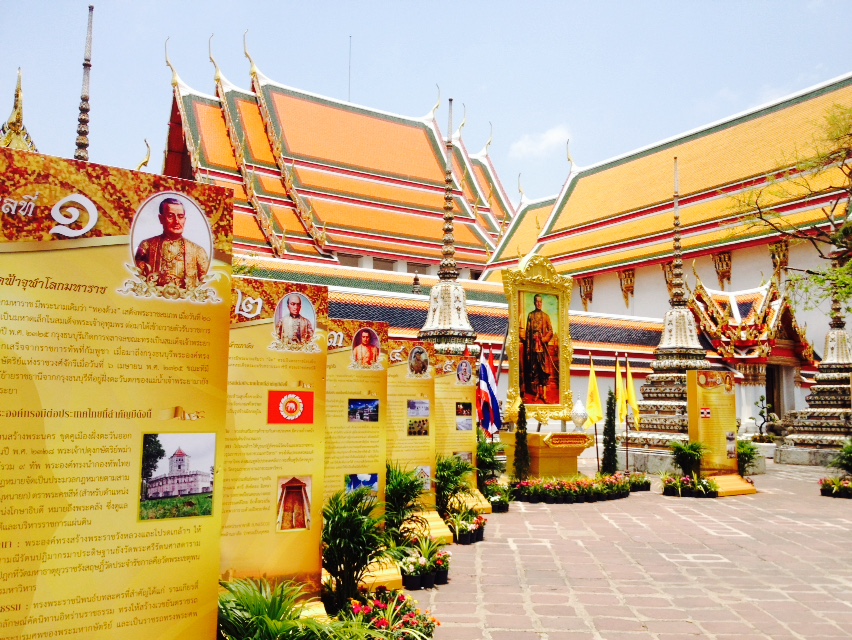
The Palace is, by every meaning of the word, grand, with what seem like miles of murals that depict an epic Indian poem, multiple Temples highly ornamented with gold leaf and glass mosaic, a miniature construction of Angkor Wat, many Buddha statues, a weapon museum, and gift shop. Another insider tip – visitors may stand in line at the box office to buy tickets for entry, or there men and women sitting at the gates near the entrance who also sell tickets.
I asked my guide if they have ever been known to sell fake tickets, but he said no. I enjoy having guides whenever I visit historical landmarks, as I prefer to have a historical and religious context of the places I visit. My guide gave me information about every building and temple we saw at The Grand palace, and information about the Royal Family and how the buildings were influenced over the years.

My guide took me to a massage parlor once we finished our tour of the The Grand Palace, which was heavenly after my long flight the day prior. The rest of the day was spent strolling the nearby flower and produce markets, we had a delicious lunch at a local restaurant, and concluded the day with the klong tour. Klongs are the canals that run throughout Bangkok. My guide told me that Bangkok is sometimes referred to as the “Venice of Thailand”.
What to Wear for this Tour:
Sunscreen
Insect repellant
Hat or umbrella (seriously, the sun is very hot)
Loose fitting, breathable clothing, i.e. cottons, linens, long skirts and pants, and shirts that cover the shoulders
Sandals or walking shoes
Chiang Mai: Elephant Daycare at Patara Elephant Farm
My departure time from my hotel was at 6:30am. My guide met me in the lobby of VIE Hotel and rode with me in the van back to the airport so I could make my transfer from Bangkok to Chiang Mai. My bag was overweight and I opted to pay the charge rather than fuss with having to carry something more. Insider tip: If traveling to Thailand via Bangkok Airways, go to www.bangkokair.com, register for Premier or Priority Flyer Bonus, and get 10-20 additional kilograms added to your standard luggage weight limit. Other airlines will have similar options.
The flight from Bangkok to Chiang Mai is one hour and a half, then a couple hour’s car ride. Once again, I was met by my Chiang Mai guide and given ice cold water and cold towels.
Chiang Mai is quaint, the original city measuring only roughly one square mile. My hotel, the Rachamankha, is located within the boundaries of the original city. This place is so incredibly unique, I could do an entire blog on the hotel alone. The Rachamankha, designed by a renowned architect father and interior designer son, has received numerous accolades and press for its design. The accommodation is the essence of Zen with ornate roof lines, the rooms centered around courtyards with beautifully manicured landscaping, rock walkways, and the entire property is decorated in the family’s own personal art collection. To stay here feels as if to be a privileged guest at an acquaintance’s extraordinary property. In the evening, spiral sticks of incense burn and subtly fill the space with fragrance.
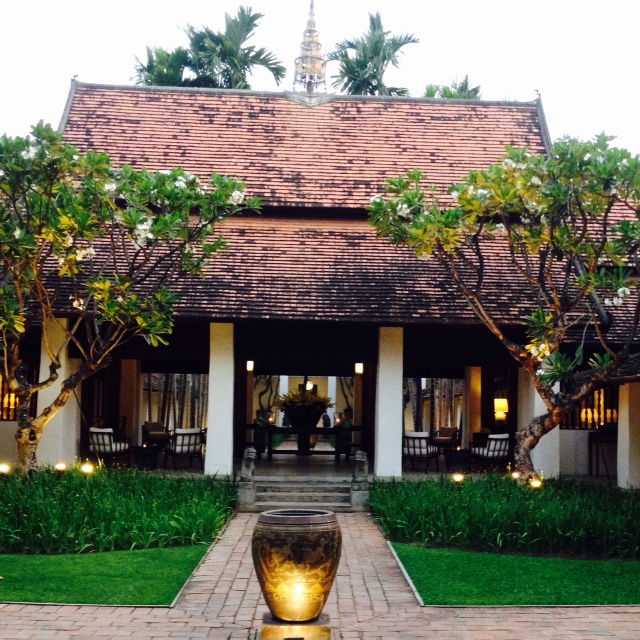
I met with the General Manager, Paul Walker, who has been managing the property for over a decade and is an utter wealth of information about the hotel and Chiang Mai. We spoke over tea, which was served out of gorgeous blue and white china. Every detail of Rachamankha is the well thought out construct of taste and imagination. Walker explained to me that the design at Rachamankha comes first over pragmatism. This is not a property that was designed under the constraints of compliance for accessibility or safety regulation. In fact, here’s another insider tip: this hotel welcomes guests age 12 and older. This is for a few purposes, one being the potential for slips and falls of smaller children; the art collection that decorates the guest rooms and common areas is priceless and must receive the necessary respect of all guests; most guest rooms (with an exception of the suites) face one another in a courtyard, so noise from small children could disturb the zenful state that this property has worked so hard to achieve.
Walker showed me the property in its entirety, which also includes a pool, a library with a collection of the owner’s books, a restaurant, and a studio upstairs from the restaurant which may be used for small meetings. Walker said small yoga groups have visited and held classes in the studio on occasion. Insider tip: there is complimentary cogniac for guests in the library.

The hotel has been a Chiang Mai favorite of celebrities, such as Angelina Jolie, according to Walker. He says that they receive repeat guests every year from all over the world, and that Rachamankha is a true home away from home for people who have come to know and love Chiang Mai. Insider tip: there is free live music from local artists almost every night in the courtyard at Rachamankha.
The months in late spring and early summer are considered “low season”, primarily because many tourists would rather not travel in the hotter months. I’d recommend travel in Thailand in April to anyone. It is hot and humid but worth experiencing the benefits of low season, like less crowding and more privacy at accommodations. For example, I went for a lovely night swim at Rachamankha and had the pool entirely to myself.
I could have spoken with Walker all afternoon about the property’s design theory and Chiang Mai’s architectural history, but I had to stay on tour schedule and visit Patara Elephant Farm.
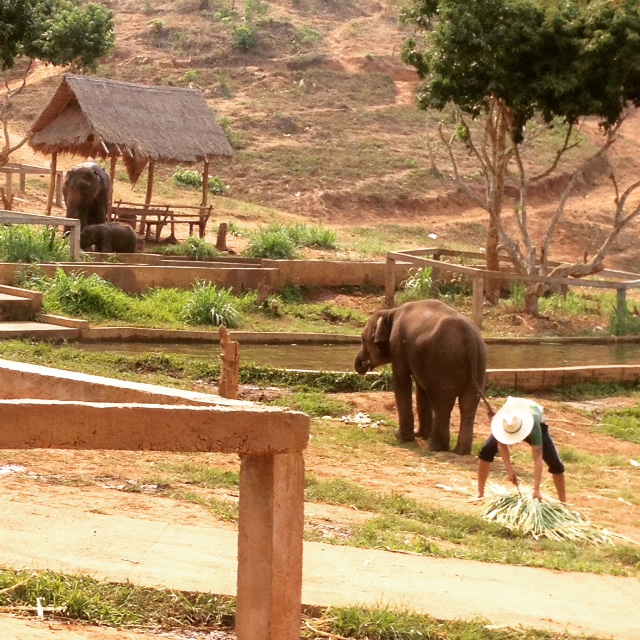
Patara is located 45 minutes outside of Chiang Mai. Journeys Within can coordinate transport for guests from their hotel in Chiang Mai to Patara. Once at Patara, guests are provided fruit, juice, and all the water they desire. I did a half-day at the farm due to my schedule, but whole day visits are also available. We first got to observe the elephants and play with a baby elephant. Then we fed the elephants, learned about the elephants, their names and commands, and bathed them. The elephants are gentile and the staff of Patara very attentive. The elephants are humanely cared for, an objective that Journeys Within prides itself. Our brand is cognizant of the humane treatment of animals on all of the tours we book. Insider tip: The staff takes photos and GoPro video which they provide on a complimentary DVD at the end of the day.

What to Wear for this Tour:
Lots of sunscreen
Lots of insect repellant
Hat
A swimsuit as a first layer, do not intend to bathe the elephants in a swimsuit alone. Thai people are modest, so visitors should dress accordingly.
Swim trunks, board shorts, tanks tops, quick-dry shirts
Sandals
Waterproof camera or camera in a waterproof case
In and Around Chiang Rai
My departure from my hotel was at 7:00am. I was met at my hotel by my guide and the drive was a few hours throughout the countryside, stopping first at natural hot springs, where visitors may dip their feet if they like, and do a little shopping and barganing. Then we stopped at The White Temple, or Wat Ong Khun, which was built in 1997 by a man renowned as the greatest artist in Thailand, Chalermchai Kositpipat, who designed and funded the project. He volunteered himself to build it, at the cost of 400 million Bhat. Insider tip: admission to the temple is currently free of charge until October 2016.
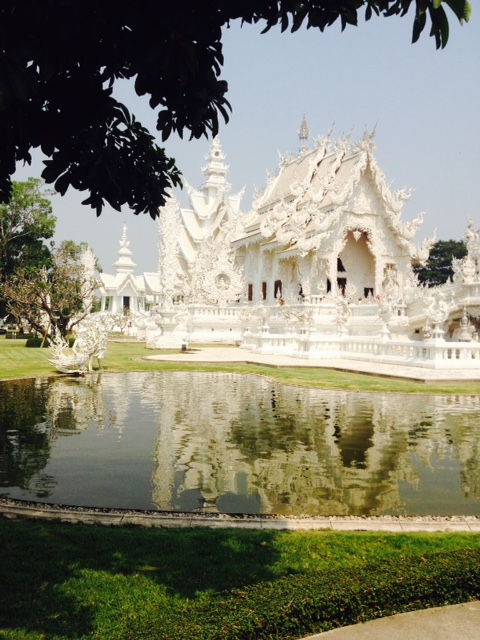
My guide told me the history of the temple and its artist, and explained details of Buddhist beliefs and how those beliefs are reflected in art. The exterior of the temple is ornate and stunning, regardless that it is only one color. There is also a museum located on the temple grounds that contains artwork by Kositpipat. The inside of the temple as well as the paintings in the museum include some unexpected depictions which are both commentary and satire on American politics. These provide an interesting Thai perspective on the Bush Administration, 9/11, terrorism, and American pop-culture. Also located on the temple grounds is “The Golden Toilet”, an ornate golden temple-like building that houses a restroom, which visitors readily wait in line to use. Insider tip: there is another restroom down the walkway behind The Golden Toilet and to the left, which is very clean and there is no line.
Throughout the rest of the tour day, we visited the villages of the Akhe tribe and the Mien tribe, stopped for an authentic local lunch, and then visited a street market just outside the border of Thailand and Myanmar. To finish off the day, we visited “The Golden Triangle”, renowned for centuries as the epicenter of the opium trade. This location offers a hilltop view of the Mekong River, with a temple situated at the top that is 1000 years old. We also visited the nearby Opium Museum, which provides a history of the opium trade, as well as information about local tribes.

There are many stops throughout this tour day and a lot of walking. As usual, I returned to an air conditioned van, ice cold water and cold towels. I stayed at Laluna Hotel & Resort, which I was relieved to find to be like an oasis away from the city after a long day of touring. Laluna’s guest rooms are centered around a large pool, and while it feels like a retreat it is a short taxi or tuktuk away from city life. Insider tip: taxis are available right outside the hotel.
What to Wear for this Tour:
Lots of sunscreen
Insect repellant
Hat or umbrella
Loose fitting, breathable clothing, i.e. cottons, linens, long skirts and pants, and shirts that cover the shoulders
Sandals or walking shoes
Next up in this series of blogs, I will journey from Thailand to Laos via riverboat on the Mekong. I will spend 12 days touring throughout Luang Prabang, Phonesavanh, Vientiane, and Paske. See more photos of this journey on our Instagram account: https://www.instagram.com/journeys_within/. I will post blogs weekly and photos depending on the strength of my hotel Wi-Fi connections, so stay tuned to get an insider account of some of our tours!… Read more »


